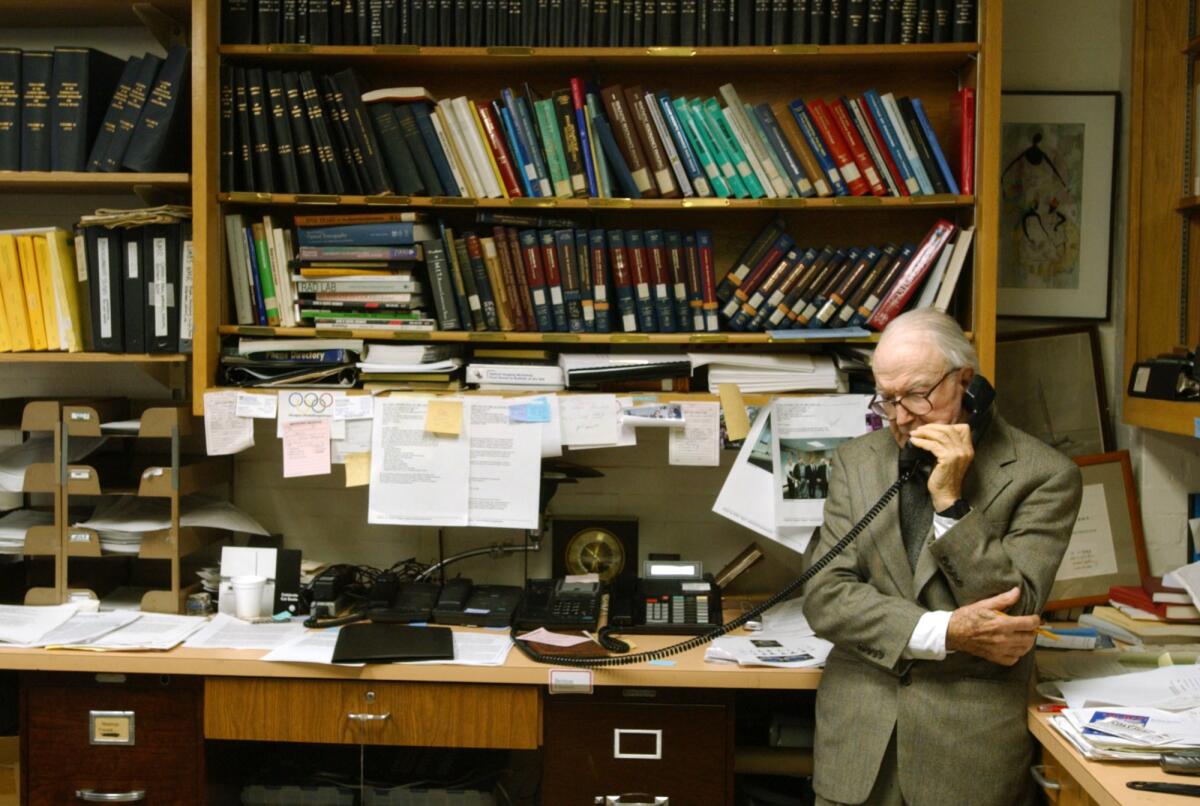Britton Chance dies at 97; pioneer in study of ultra-fast reactions in human biology

Molecular biologist Britton Chance, who combined an expertise in electronics and automation with a knowledge of physiology to pioneer the study of ultra-fast reactions in human biology, died of heart failure Nov. 16 at the Hospital of the University of Pennsylvania in Philadelphia. He was 97.
An accomplished sailor who won a gold medal in yachting at the 1952 Summer Olympics in Helsinki, Chance was a protean researcher who worked on radar systems during World War II, developed optical imaging techniques for studying fast biochemical reactions and proved key biochemical concepts about enzymatic reactions.
His early studies helped lay the groundwork for magnetic resonance imaging of humans. In his later years, he was developing techniques to image the brain as a form of lie detection and to use infrared measurements of the breast to detect tumors.
All chemical reactions in living organisms are carried out by proteins called enzymes, which provide the specificity necessary for the production of the chemicals required for cells to carry out their functions. When Chance was still a graduate student in the early 1940s, researchers knew that the relationship between enzymatic activity and the concentration of the chemicals the enzymes operated on, called substrates, could be explained by the existence of an intermediate enzyme-substrate complex, but this complex appeared and disappeared so rapidly that it had never been seen.
To get a closer look, Chance developed a technique called “stopped-flow spectrophotometry.” A solution of the enzyme was placed in one syringe and the substrate and other reactants in a second. When both plungers were pushed simultaneously, the two solutions were mixed in the chamber of a spectrophotometer, where the rapid reaction could be followed by changes in the optical absorption of the chemicals involved. By varying concentrations of the reactants, Chance confirmed that the rate of formation of the complex was limited by the number of collisions between the enzyme and the substrate.
In studies after World War II, he also showed that the overall rate of the reaction was governed by the rate of release of product from the complex, a postulate now called the Theorell-Chance mechanism. Reflecting the importance of this work, Chance named his yachts Complex I, Complex II and so on.
He later studied the creation and release of energy in mitochondria, the “powerhouses” of cells, developing a series of instruments — including the dual wavelength spectrophotometer and a new form of fluorescent spectrophotometer — that helped monitor changes within the organelles. In the 1970s, he was the first to use magnetic resonance spectroscopy on a whole organ, the brain of a hedgehog.
Britton Chance was born July 24, 1913, in Wilkes-Barre, Pa., a child of privilege. His father, Col. Edwin M. Chance, was president of United Engineers & Constructors Inc., which built power plants. The young Chance had a lifelong interest in sailing and, as a teenager, invented and patented an automatic pilot to keep a ship on course that he tested on his father’s 105-foot ketch on a 1935 trip to the West Indies.
While Chance was in graduate school at the University of Pennsylvania, the British General Electric Co. made him an offer he couldn’t refuse. If he would install the pilot on a 20,000-ton freighter and go along on a three-month test cruise to Australia, the company would pay his tuition to Cambridge University. The day after his marriage to 17-year-old Jane Earle, the 24-year-old Chance set sail on a combination honeymoon and business venture, then enrolled at Cambridge.
After a visit to his parents in 1940, he was unable to return to England because of the war and re-enrolled at Pennsylvania, receiving his doctorate in physical chemistry from that school in 1941 and another from Cambridge in physiology in 1943.
He was recruited to MIT’s famed Radiation Laboratory to work on the team that developed and enhanced radar. His first project was developing radar for blimps searching for submarines off the U.S. coast. Later, he worked on radar-guided bombs. Despite his youth, by war’s end he was leading a team of more than 300 people.
When the International Olympic Committee announced the addition of a 5.5-meter yachting class for the 1952 Summer Olympics, Chance commissioned the construction of the Complex II. He got the U.S. berth because he was the only entry in the challenge series arranged by the U.S. Olympic Committee. His crew was made up of twins Edgar and Sumner White and teenager Michael Schoettle, all of whom had previously sailed with Chance at the Mantoloking Yacht Club in Pennsylvania.
The Complex II won two of the first six races in the regatta, but a gold medal would require not only a win in the seventh, but that competitor Peder Lunde of Norway finish no higher than fifth. Amazingly, Chance blocked Lunde’s wind early in the race, putting him out of contention, then sailed in for the win.
In the 1950s and ‘60s, he led the U.S. national governing body of sailing.
He received the National Medal of Science in 1974 and honorary medical degrees from many universities, as well as many other awards. He spent most of his career at the University of Pennsylvania and, after his retirement in 1983, became president of the Medical Diagnostic Research Foundation in Philadelphia.
Chance, whose first two marriages ended in divorce, is survived by his third wife, Shoko Nioka, whom he married in a traditional Chinese ceremony in Taiwan in February, as well as 11 children, five stepchildren and numerous grandchildren and great-grandchildren.



